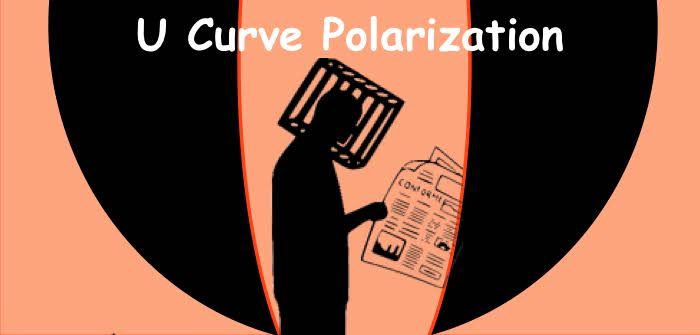Johnson and his team have found that when it comes to digesting news of any kind, Americans now exist in a state of pure polarization: the size of the extremes of the left and right are now so large that they outnumber those in the middle ground.
Comment: Pure polarization would mean there is no middle ground.
As a physicist, Johnson is used to seeing populations sorting into bell curves - think of heights and weights, he says. So one might expect that people would naturally sort into this normal distribution when it comes to ideology. Not so. It doesn't even matter whether news is real or fake, let alone left or right: The mere act of absorbing news that everyone else is seeing causes a polarizing effect.
"Even on issues for which there is no conceivable counter-evidence, a surprisingly large number of people may [take] an 'anti-crowd' viewpoint, e.g. the many people who believe the world is flat and attended the 2017 Flat Earth International Conference," Johnson and his team write. "Even within the community of professional scientists, there is a non-zero 'anti-crowd' that are skeptical about global warming."What causes this to occur? Johnson's finding hinges on a basic assumption: that people make decisions based on rewards. Johnson compares his model to what happens when someone makes an investment decision based on a piece of information. If that individual gets a return on her investment, she will continue to assign value to the piece of information, as well as the source itself, until the returns start to dissipate.
Johnson finds that if you assume news consumers act on a piece of information using their own mental rewards system to make a decision like, say, voting, they will naturally polarize. Johnson's model reproduces what Facebook researchers themselves have observed in their own data in terms of a U-shape showing large sub-populations with beliefs towards the extremes. It's also confirmation of a 2014 Pew Research Center study that found a strong correlation between political engagement and polarization.
Comment: Really, Sherlock? Why is this an outstanding revelation?
Johnson says that it's not clear whether the polarization represents a new phenomenon, or whether it's now just easier to model. But he has a hunch that more Americans now consume news than in the past - and that's bringing out latent polarization that's always been there.
"I think it has to do with common information - everybody hears the same news, whereas in the past, it was, 'Have you seen the news, or read the paper,'" he said. "More people are seeing news that they wouldn't have seen in the past."
Comment: Where is the statistical proof for this speculation on 'latent polarization'? You are polarized or you are in a zone of consideration, or you don't give a flip. AND, everyone doesn't hear/see the same news - nor absorb the 'information' in the same way. By refining mental filters, people are progressively able to determine truth from persuasion or propaganda.
Is there any sign of hope? Johnson says: Not really - Facebook and other social media companies currently have plans to change their algorithms to draw people together more than before, by connecting people who are friends of friends. While that will draw together a lot of people, it will also likely increase the probability for extremism.
Comment: When extremism reaches a majority, it is no longer the extreme.
"It's like using superglue at home when trying to fix something with many pieces," he said in a follow-up email. "Some will go toward gluing together what you want, but some spills out and glues together precisely the bits that you don't want glued and hence strengthened: the extremes."
So how can we unglue people? Johnson says a way to start would be to somehow assign less value to the news that's coming out.
"It's like using superglue at home when trying to fix something with many pieces," he said in a follow-up email. "Some will go toward gluing together what you want, but some spills out and glues together precisely the bits that you don't want glued and hence strengthened: the extremes."
So how can we unglue people? Johnson says a way to start would be to somehow assign less value to the news that's coming out.
"[If] our first connection is through information, that's the tie that's got to be broken."




Comment: "[If] our first connection is through information, that's the tie that's got to be broken." Precisely MSM's agenda. Polarization is step one for MSM biased news. Step two: eliminate alternate news. Step three: MSM 'news' becomes the new truth. This is the concept that should be explored, not the bogus ideas above.